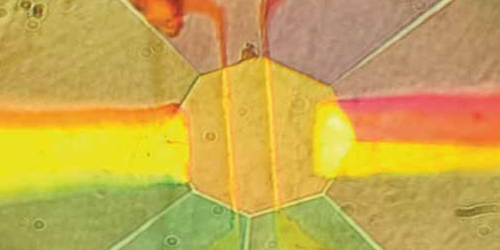Revamp for High-Pressure-Superconductivity Measurements
At pressures above 90 gigapascals (GPa), sulfur switches from behaving like a nonmetal to behaving like a metal. Lower the temperature and the highly pressurized metal then starts superconducting. Reaching such prodigious pressures requires placing the sulfur in a diamond-anvil cell, a device that previously precluded the making of all but the simplest measurements of the system. Now, however, Feng Du of the Max Planck Institute of Chemistry, Germany, and his collaborators have instrumented a sulfur sample held at a pressure of up to 160 GPa [1]. Their achievement could allow researchers to probe the high-pressure properties of the growing number of materials that have recently been found to superconduct in this pressure regime.
At a pressure of 160 GPa and a temperature of 17 K, electrons in sulfur pair up, forming a collective state that can flow without resistance. The further the temperature drops below 17 K, the more energy is required to cleave the paired electrons, making the superconducting state more robust.
Theory connects the size of the cleaving energy, which is known as the superconducting gap, to the magnitude of the current that tunnels from a normal conductor to a superconductor when the two materials sit on either side of an insulating barrier. Du and his collaborators fashioned such a “tunnel” junction from sulfur (superconductor), tantalum (metal), and tantalum pentoxide (insulator). The choice of insulator was crucial. Tantalum pentoxide’s high density and stability ensured that the layer’s thickness would not change under the high pressure.
Using this setup, Du and his collaborators measured sulfur’s superconducting gap, finding a value that matched theoretical predictions. The researchers say that they look forward to using their tunnel junction design with more exotic, less understood materials, such as hydrides and nickelates.
–Charles Day
Charles Day is a Senior Editor for Physics Magazine.
References
- F. Du et al., “Tunneling spectroscopy at megabar pressures: Determination of the superconducting gap in sulfur,” Phys. Rev. Lett. 133, 036002 (2024).




